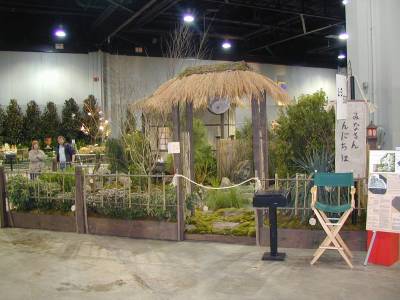
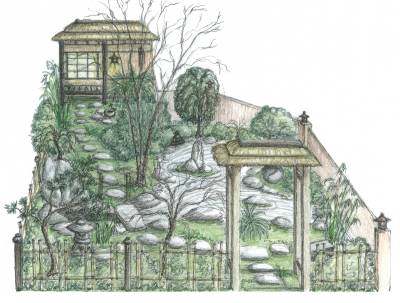

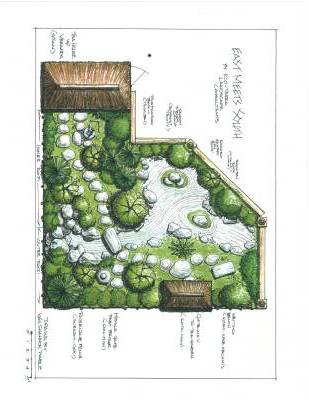
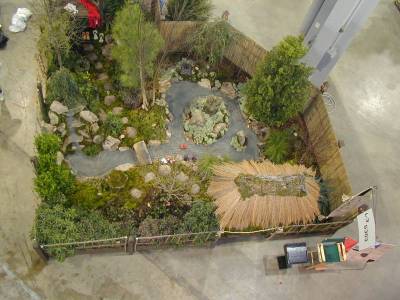
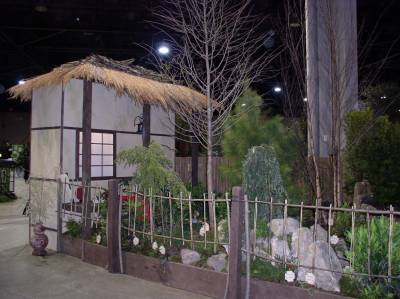
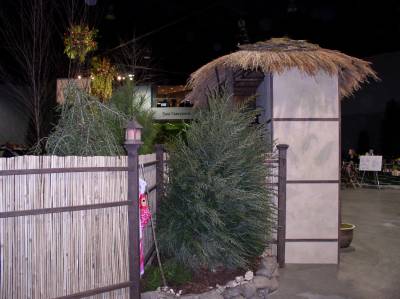
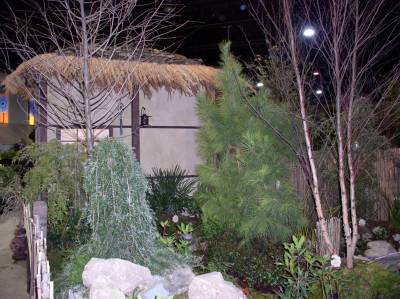
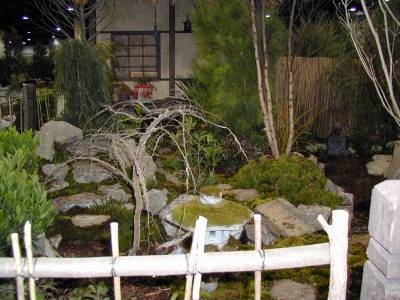
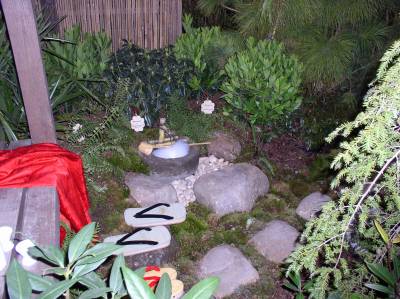
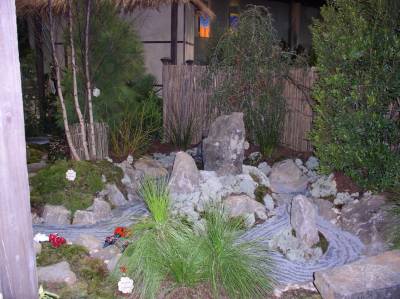
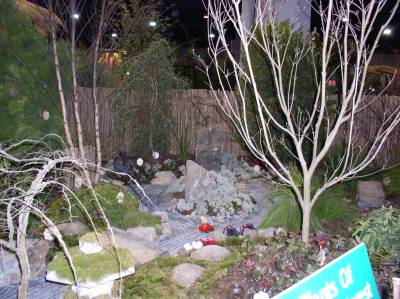
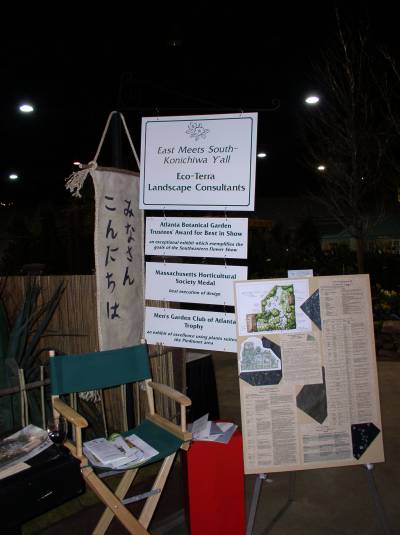
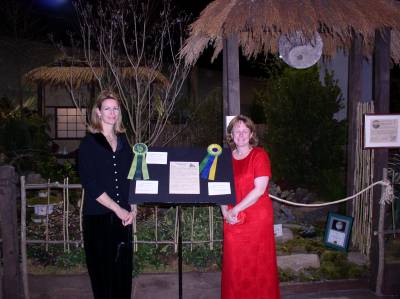
Southeastern Flower Show 2003
Landscape Division
Statement of Purpose for the Garden Exhibit
East Meets South - Konnichiwa Ya’ll
Exibit Title: East Meets South - Konichiwa Y’all
Theme: What would happen if you took a little bit
of East and a little bit of South and mixed
them together? Well, let’s put our typical Southern family
into a Far Eastern garden setting…perhaps
a Japanese Tea Garden…and include a drought
tolerant Zen garden! Then, let’s substitute OUR Eastern and Southeastern
native plants and…. ‘get jiggy with it’! Imagine the giggles of the children if set
loose in the Zen Garden (aka BIG sandbox). With the children so occupied, imagine what
y’all can do in the Tea House…
USDA Zone, Location, Season, Exposure: Zones 7-8. Hotlanta! The season is Winter. The pathway to the Tea House is dappled shade
while the Zen garden area is full sun.
Special Techniques: This garden was inspired by the peace and
tranquility offered by a “traditional” Japanese
Tea Garden then blending in the Southern
tradition. We accomplished this by using
only Eastern/Southeastern native plants,
also demonstrating the versatility of our
native plants. Just as Asian plants have occupied traditional
Southern gardens for generations, so can
our native plants occupy traditional gardens
of all styles. Note the thatched roof, which is hand made
of our native Broomsedge and the fencing
is of our native Rivercane, Tulip Tree, and
Willow. This garden also demonstrates the use of
small garden spaces, drought tolerant landscaping,
and xeriscaping. So follow the dewy path of the lovers to
the teahouse or play in the sand with the
kids…whichever suits your fancy. As the note on the garden gateway reads:
“Dear Rhett San,
The kids are busy in the sandbox…meet me
for Sake and ??? in the Tea House! Scarlet”
(Please refer to the Terminology Worksheet
for more detailed information on the significance
of the facades & props used)
Special Research: This garden design has been quite challenging
in that it required much research on our
part to accurately design the Japanese Tea
Garden. Everything from the shape of the Zen sand
area, the waterfall, the rock formations,
gateways, purification basin, plant color/texture,
tea house design…and more are rooted in early
Shinto/Buddhism tradition as well as that
of the great early Tea Masters’ philosophy
and design…minus the children and frolic
in the Tea House.
There are typically little if any flowers in the traditional tea garden (too distracting). Rather you find solid green leaves (instead of variegated) so more emphasis is placed on texture, form, and placement of objects (such as rock and bark). It is the family that brings the ‘flowers’ to this garden; represented by the red objects, color opposite of green and representative of the South in Feng Shui (note the kimono, chopsticks, windsock, children’s toys). Since the Tea Garden is a place of quiet, humble meditation/ceremony, the design must be soft, soothing, and easily converging with nature; it is never ostentatious. Much emphasis is placed on the gently winding dewy pathway or ‘roji’.
The following books were a great resource
of information: Creating Japanese Gardens By Philip Cave, Japanese Garden Design By Marc P. Keane, Japanese Gardening in Small Spaces By Isao Yoshikawa, The Japanese Garden- Islands of Serenity By Haruzo Ohashi, Feng Shui in the Garden by Nancilee Wydra, Japanese Garden and Floral Art by Mrs. Paul Kincaid.
Unique Plant Material: We selected many weeping species, since this
graceful form is most often seen in Japanese
Gardens, as well as plants with unusual bark
or texture such as Weeping Elm, Weeping Yaupon,
Bald Cypress, Weeping Hemlock, Weeping Yucca,
Weeping Redbud, and Needle Palm.
Other: “The viewer does not physically enter the
garden but rather explores it mentally. In this case, what is actually a rather small
garden could be found limitless, expressing
the philosophic idea (included in but not
exclusive to Zen) of finding vast in small.” And a few words on Yin & Yang…”It was
believed that all universal things oscillate
between these opposites, and landscape design
sought to balance these opposites to create
harmony.” Source: Creating Japanese Gardens
Foot-noteNo. |
Common Name |
Botanical Name |
Zone |
Size HxW |
Growing Conditions |
Care-Easy-E Mod-M Hard-H |
Comments |
|
|
1 |
Rivercane |
Arundinaria gigantea
|
5-9 |
20x? |
Wet/moist soil/ part-full shade |
E |
Our native bamboo; Good for streambank restoration
and erosion problems in place of Asian
species;
Spreading but not choking habit. |
|
|
2 |
(Bonsai) Carolina Hemlock |
Tsuga caroliniana |
5-7 |
60x25 |
Moist/well-drained soil /full-part sun |
E/M |
More tolerant of warm climate than Canadian
Hemlock |
|
|
3 |
Needle Palm |
Rhapidophyllum hystrix
|
6-10 |
6x10 |
Well drained soil/part shade |
E |
Most cold tolerant of all palms. Supposedly hardy to –10 degrees. |
|
|
4 |
Florida Anise |
Illicium floridanum |
6-9 |
8x8 |
Moist soil/part shade |
E |
Evergreen; Aromatic leaves and flowers; Grows
best in rich organic soil in partial
shade. |
|
|
5 |
Rhododendron |
Rhododendron catawbiense ‘Boursault’ |
4-8 |
10x10 |
Moist/well drained soil /part-full sun |
E/M |
Better in cooler climate north of Atlanta. |
|
|
6 |
Christmas Fern |
Polystichum acrostichoides |
3-8 |
1.5x3 |
Fertile/moist soil/full-part shade |
E |
Evergreen; Drought tolerant; Easy to grow |
|
|
7 |
Weeping Canadian Hemlock |
Tsuga canadensis ‘Pendula’ |
4-8 |
12x25 |
Moist/well-drained soil /full-part sun |
E/M |
Weeping habit; Better adapted to cooler climate
in the north and mountain areas. |
|
|
8 |
Southern Wood Fern |
Thelypteris kunthii |
7-10 |
3x3 |
Wet/moist soil/part sun |
E |
A versatile evergreen to semi-evergreen fern
that grows quickly and can take morning
sun |
|
|
9 |
Bald Cypress |
Taxodium distichum |
5-10 |
80x25 |
Wet/moist/ average soil/full sun |
E |
A deciduous conifer, normally found in wet
sites, but tolerant of urban and suburban
conditions; Fast growing |
|
|
10 |
Striped Winter Green |
Chimaphila maculata |
5-8 |
6”x6” |
Moist/well drained soil /part-full shade |
E/M |
Evergreen; Prefers well drained acidic soil;
Commonly found under pines in Piedmont |
|
|
11 |
Weeping Carolina Hemlock |
Tsuga caroliniana ‘LaBar Weeping’ |
5-7 |
7x20 |
Moist/well-drained soil /full-part sun |
E/M |
Weeping habit; More tolerant of warm climate
than Canadian Hemlock |
|
|
12 |
Ginger |
Hexastylis arifolia |
6-9 |
6”x1’+ |
Moist/well-drained soil /full-part shade |
E |
Spreading; Evergreen; Prefers rich organic
soil |
|
|
13 |
Crane Fly Orchid |
Tipularia discolor |
4-9 |
2”x4” |
Moist/well drained soil /part-full shade |
E |
Leaves commonly emerge in the fall as green
with purple undersides; Leaves disappear
in spring followed by a 10”-12” stalk
of
small purple/brown flowers. |
|
|
14 |
Ebony Spleen Wort |
Asplenium platyneuron
|
3-9 |
10”x10” |
Moist/well drained soil /full-part shade |
E |
Evergreen; Drought tolerant; Easy to grow |
|
|
15 |
Partridge Berry |
Mitchella repens |
4-9 |
1”x1’+ |
Moist/well drained soil /full-part shade |
E |
Evergreen; Spreading; Prefers soil high in
organic matter; Has red berries in fall. |
|
|
16 |
Anisetree |
Illicium parviflorum |
6-9 |
10x10 |
Moist soil/part shade |
E |
Evergreen; Aromatic leaves and flowers; Grows
best in rich organic soil in partial
shade |
|
|
17 |
Loblolly Pine |
Pinus taeda
|
6-9 |
75x30 |
Variable soil /full sun |
E |
Fast Growing; Common Pine in Piedmont |
|
|
18 |
River Birch |
Betula nigra |
4-9 |
60x40 |
Moist/well drained soil /full sun |
E |
Normally found along rivers/streams, but
tolerant of urban and suburban conditions;
Exfoliating bark |
|
|
19 |
Ground Cedar |
Lycopodium digitatum |
4-8 |
6”x1’+ |
Moist/well-drained soil /full-part shade |
H |
Spreading; Evergreen; Prefers acidic soil;
Difficult to transplant and establish. |
|
|
20 |
Rhododendron |
Rhododendron catawbiense ‘Purpureum Elegans’ |
4-8 |
10x10 |
Moist/well drained soil /part-full sun |
E/M |
Better in cooler climate north of Atlanta. |
||
|
21 |
Weeping Elm |
Ulmus alata ‘Lace Parasol’ |
6-9 |
10x15 |
Moist/well drained soil/full sun |
E |
Weeping habit; Corky bark makes for great
winter interest. Resistant to Dutch Elm Disease. |
||
|
22 |
Doghobble |
Leucothoe axillaris |
6-9 |
3x5 |
Moist soil/part-full shade |
E |
Evergreen; Suckering shrub; Grows best in
rich moist soil in shade. |
||
|
23 |
Galax |
Galax urceolata |
5-8 |
6”x1’+ |
Moist/well-drained soil /full-part shade |
M |
Spreading; Evergreen; Needs rich organic soil. |
||
|
24 |
Dogwood tree |
Cornus florida |
5-8 |
20x25 |
Moist/well-drained soil /part shade |
E |
A long-admired staple of the Southern Garden. Can suffer from leaf spot and powdery mildew
under stress. |
||
|
25 |
Long Leaf Pine |
Pinus palustris |
7-10 |
100x40 |
Well drained/sandy soil/full sun |
E/M |
More commonly seen in Lower South; Slow Growing;
Deep-rooted. Easy to grow in Coastal Plain, more difficult
in Piedmont |
||
|
26 |
Weeping Yucca |
Yucca recurvifolia |
6-9 |
6x6 |
Moist/well drained soil/ full sun |
E |
Weeping habit on older leaves; Large stalks
of white/creamy flowers in summer |
||
|
27 |
Red Osier Dogwood |
Cornus sericea
|
2-8 |
6x10 |
Wet/Moist soil /full sun |
E/M |
Suckering shrub good for wet areas. Best
in cooler climates. Newer growth is bright red. Good winter interest. |
||
|
28 |
Wax Myrtle |
Morella cerifera |
6-9 |
15x15 |
Moist/well-drained soil/full sun |
E |
Evergreen; Suckering; Very durable and tolerant
of a wide range of conditions; Drought
tolerant;
Good for hedges. |
||
|
29 |
Soft Rush |
Juncus effuses |
6-9 |
2’-3’ |
Wet/moist/dry Full sun/part shade |
E |
An easy to grow evergreen ornamental grass |
||
|
30 |
Weeping Yaupon |
Ilex vomitoria ‘Pendula’ |
7-10 |
20x15 |
Varied soil/full sun |
E |
Weeping habit (female in show); Needs male
yaupon for pollination. |
||
|
31 |
Path Rush |
Juncus tenuis Willd, |
2-9 |
18”x18” |
Full Sun to Shade |
E |
An easy to grow partial evergreen ornamental
grass |
|
|
32 |
Yellow Twig Dogwood |
Cornus sericea 'Flaviramea'
|
2-8 |
4x6 |
Wet/Moist soil /Sun |
E/M |
Suckering shrub good for wet areas. Best
in cooler climates. New growth is bright yellow |
|
|
33 |
Canadian Hemlock |
Tsuda canadensis |
4-8 |
80x30 |
Moist/well-drained soil /full-part sun |
E/M |
Better adapted to cooler conditions in the
north and mountain areas |
|
|
34 |
Creeping Phlox |
Phlox subulata ‘Candy Strip’ |
3-8 |
3”x24” |
Full Sun/dry |
E |
An easy to grow ever-green dense ground cover.
Pink/white flowers in spring. |
|
|
35 |
Weeping Redbud |
Cercis canadensis ‘Covey’ |
5-7 |
5x8 |
Moist/well-drained soil /full-part sun |
E/M |
Weeping habit; Moderate growth; Good specimen |
|
Southeastern Flower Show 2003
Landscape Division
|
Footnote Letter |
Japanese Landscape Feature/Prop |
TranslationIf applicable |
|
A |
Soan |
The simple thatched roof Tea House that is
the apotheosis of tea architecture. The roof is hand made of Broomsedge roof. |
|
B |
Wind Chime Tranquility Symbol |
|
|
C |
Chiriana |
Dust pit |
|
D |
Tsukubai |
Arrangement of stones found in the tea garden
that includes a water basin (chozubuchi)
used to purify hands and mouth before
entering
the tearoom |
|
E |
Chozubachi |
The water laver or purification basin |
|
F |
Roji, inner |
Starts after second threshold (bridge) |
|
G |
Roji, Outer or Soto roji |
Outer roji; path after the outer gateway (soto-mon) |
|
H |
Sukashi-gaki |
See through fence or open lattice fence hand
made of Rivercane, Willow, and Tulip
tree |
|
I |
Roji |
Literally ‘dewy path’ |
|
J |
Tobi-ishi |
Step stones |
|
K |
Chu-mon |
Middle gate; marks the division of outer-roji
and inner-roji |
|
L |
Ryu-mon-baku |
Dragon’s gate water fall; also dry water
fall |
|
M |
Ishidoro |
Stone lantern |
|
N |
Ryu-sui |
Stream like sand patterns |
|
O |
Kokoro shaped sand area |
The written character, meaning ‘enlightened
heart’; |
|
P |
Kare-san-sui |
Dry mountain water |
|
Q |
Sanzon-ishi-gumi |
An arrangement of three stones in a triangular
form that represent the Buddhist trinity. |
|
R |
Shumisen |
The central, immovable mountain of Buddhist
cosmology; |
|
S |
Koshi-kake-machiai |
Waiting bench |
|
T |
Fumiwake-ishi |
Large junction stone |
|
U |
Soto-mon |
Outer gateway to Tea Garden (first threshold
of the roji) |
|
V |
Necklace- Japanese Love Pendant |
|